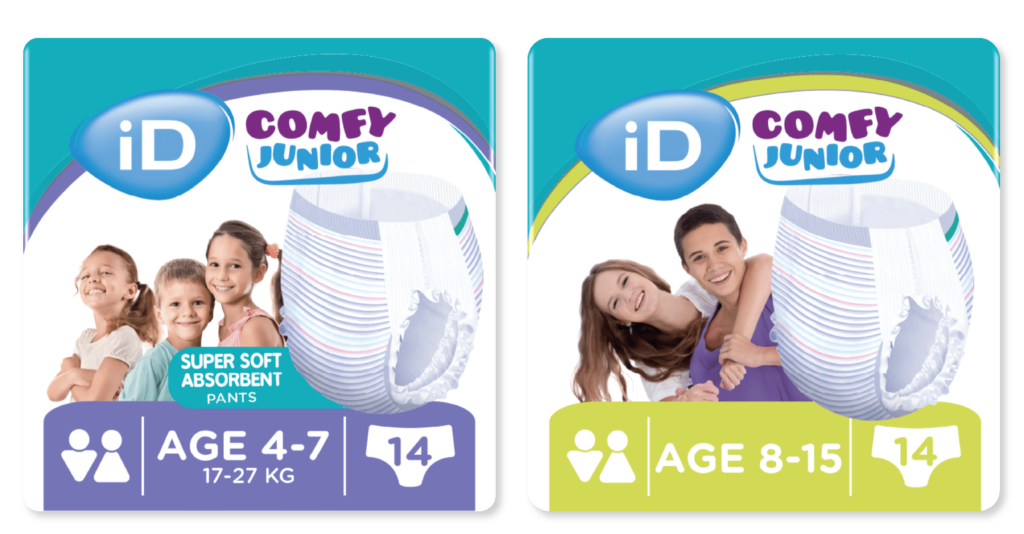Your Simple Guide to Understanding Incontinence Stages and Choosing the Right Products that Suit You
Introduction
Managing incontinence can be challenging, but the good news that it's crucial to recognize that it's a common and manageable condition. It's a journey unique to each individual so this blog aims to explain the significance of understanding the diverse stages of incontinence and how selecting the appropriate products can empower you to regain control, confidence, and an active lifestyle. Let's break it down and explore the products that can help you or your loved ones manage this situation more comfortably.
Stage 1: Occasional incontinence or stress incontinence
If you're experiencing occasional leaks, particularly during activities like sneezing or coughing, consider using incontinence pads or liners with light absorbency. These discreet shields effortlessly fit into your regular underwear, effectively managing minor leaks without any hassle. When delving into the frequently asked question, "Can stress cause frequent urination?", in our blog, we explore the intricate connection between mental well-being and bladder health, providing valuable insights and improvement tips.
The products can be worn in your own underwear.
 |
iD Light Advantages:
- Discreet and comfortable protection.
- Provides a sense of security during everyday activities.
- Helps avoid awkward moments that can arise from unexpected leaks.
Do you want a 20% discount on your first order?
Receive incontinence tips, expert advice, and promotions by email.
Stage 2: Moderate or urge incontinence
If you find yourself dealing with more frequent and sudden urges to use the bathroom, then it could be time for something with a bit more defence. Look for absorbent pads or pants with higher absorbency. They not only provide better protection but also control any unwanted odours, letting you go about your day confidently.
If you are still active and want maximum protection, then consider pants with higher absorbency. However, you don’t have to let your life be ruled by bladder weakness. You can read our blog about a step-by-step guide to some bladder control exercises that may help improve your symptoms: Easy Pelvic Floor Exercises: how to strengthen weak bladder muscles (id-direct.com)
 |
iD Pants Advantages:
- Improved absorbency and protection against moderate leakage.
- Improved odour control for increased confidence.
- Elasticated waist and leg openings for a secure and comfortable fit. (for iD Pants)
 |
Stage 3: Severe incontinence or overflow incontinence
In this stage, where leaks become more constant with more urine, then it could be time for the next level of protection. Highly absorbent adult all-in-one style or briefs are your go-to. They offer maximum absorbency, adjustable tabs for a custom fit, and advanced anti-leak features to keep you feeling secure. The constant contact with urine or faeces can result in skin breakdown, inflammation, and infections. It's crucial to address these concerns promptly to maintain skin health and prevent complications. For further insights into incontinence and its impact on skin integrity, read the interview with Prof. Dimitri Beeckman titled "Incontinence and Skin Integrity (AID)."
For maximum protection, we recommend our Slips wall-in-one products.
 |
iD Slip Advantages:
- Maximum absorbency for strong leakage protection and long-lasting comfort.
- Provides excellent containment, reduces the risk of leakage.
- Adjustable tabs for a secure and custom fit.
Stage 4: Faecal incontinence
If you're dealing with faecal incontinence, where it's about solid waste, it's essential to note that stool is not absorbed by a product this is designed primarily for fluids. Thus, we recommend choosing products with lower absorption and to change them more often. If you're still very mobile, then iD pants could be a good option. For mobile, consider an all-in-one product like the iD Slip.
Advantages:
- odour control to maintain freshness and discretion.
- Soft and hypoallergenic materials for sensitive skin.
Result:
Incontinence doesn't have to be a barrier to living life to the fullest. Managing continence care can be different for each person, so finding the right product for you can make a significant difference. Whether it's a light pad, discreet pants, or all, the goal is to help you regain confidence and an enjoyable lifestyle. Just discreet pants
Remember, talking to healthcare professionals is key for personalized advice on managing incontinence effectively.
What’s the link between bedwetting and ADHD?
ADHD (Attention-deficit hyperactivity disorder) is a relatively common condition that affects a person’s behaviour, which can become evident in childhood, particularly when a child starts school1. In fact, studies show that around 2% to 7% of people experience ADHD globally2. While there are many signs that a child may have ADHD, such as difficulty maintaining attention on tasks, fidgeting and trouble waiting for their turn and sharing3, bedwetting can also be an indicator of ADHD4. Read on to find out why, and how you can manage this combination of issues in children.
What do we mean by ADHD?
Attention deficit hyperactivity disorder (ADHD) is a condition that affects how a person behaves. It is usually diagnosed when a child is under 12 years old, if it wasn’t picked up when they started school initially5. It is a neurodevelopmental disorder, meaning it affects the development of the brain, and refers to a pattern of behaviour that affects a child in most situations6. While symptoms may change as a child matures, the two main signs of ADHD are inattention and hyperactivity7. These can be seen in the following behaviours:
- having difficulty focusing on tasks
- being forgetful
- being easily distracted
- having trouble sitting still
- interrupting others when they’re speaking8.
Despite its commonness, little is known about what causes this condition, but it is believed to potentially have neurological and/or genetic origins9. There is, unfortunately, not just one test to diagnose ADHD, so your doctor will likely assess any ADHD symptoms your child has been experiencing for the past six months, as well as do a physical exam and take a medical history to rule out any other potential causes10.
Furthermore, ADHD is the most common coexisting condition for children with autism, though the two may also be confused due to similar presenting signs11. It’s important to seek help through your doctor if you suspect your child has one or both of these conditions, particularly if you have any concerns. Nonetheless, with the correct support, people with these conditions can lead happy, fulfilling lives12.
How are ADHD and bedwetting linked?
As we said, ADHD and bedwetting can be linked; in fact, the rate of accidents is almost three times higher in children with ADHD19. While it’s not entirely clear why, some research has suggested that this connection may be due to ADHD causing a developmental delay in the central nervous system, which may cause children to not recognise when their bladder is full20. Also, the link between ADHD and bedwetting could be caused by the following:
- a lack of impulse control, causing a child with ADHD to miss their body’s cues that they need the toilet
- changes in sleep due to hormonal changes
- increased stress if a child is always ‘on the go’
- behaviour differences that lead a child to struggle to read their normal bodily cues21.
If your child is wetting the bed due to ADHD, the iD Comfy Junior range is a good option to consider. The iD Comfy Junior Pants are suitable for children from eight to 15 years old. They fit just like normal underwear, offering a great absorbency capacity and maximum discretion and comfort. We highly encourage you to seek a doctor's opinion to learn how to support your child further.
What counts as bedwetting?
Bedwetting is also very prevalent in children, with around 15% of children over seven years old experiencing it13. It can run in families, and most children and young people will grow out of it14. Also known as nocturnal enuresis, it is when a person involuntarily urinates while asleep15. There are many things that could cause bedwetting, including:
- a bladder that cannot stretch enough to hold urine
- not waking up when their bladder sends a signal that it’s full16
- stress17
- an overactive bladder
- constipation
- urinary tract infections (or UTIs)
- family history
- ineffective bedtime routines18.
If you have any concerns about your child’s health, we recommend that you speak to your doctor.
How to manage bedwetting caused by ADHD
Both bedwetting and ADHD can be difficult conditions for parents to cope with. Nonetheless, there are lots of tips and tricks you can follow to help manage nocturnal enuresis, such as:
- encouraging your child to drink enough throughout the day, but limit drinks in the run-up to bedtime
- avoiding caffeinated and fizzy drinks, such as colas, which can stimulate the bladder
- a bedwetting alarm
- a mattress protector and training pants, like iD Comfy Junior Pants, at night-time
- a calendar to track progress and see how well management techniques are working22
- developing a toileting schedule to help your kid to remember to listen to their body’s cues
- encouraging your child to go to the loo right before bedtime23.
With all these tips in your arsenal, you’ll be sure to reduce any distress caused by bedwetting and ADHD.
How can you protect your mattress from bedwetting leaks?
Bedwetting (or nocturnal enuresis) refers to the involuntary leaking of urine while you sleep1. While the percentage of kids experiencing this condition decreases as they get older, it’s still a fairly common condition, affecting around 21% of four-and-a-half-year-olds2. Nonetheless, older children and adults can experience it too, and can be very frustrating, particularly when it comes to protecting your mattress from leaks. Read on for our top tips on managing night-time leaks and keeping your furniture dry.
What is bedwetting?
Bladder issues are common in young children as they are being potty trained3. However, the frequency of bedwetting does decrease with time; once they reach nine-and-a-half years old, only 8% of children are wetting the bed and this drops further to around 3% of adolescents and about 1% of adults4. While it’s often just a perfectly natural part of growing up, other things can cause nocturnal enuresis, including:
- the bladder not stretching enough overnight to hold wee
- producing too much urine at night
- not waking up when their bladder is full5
- a hormonal imbalance
- a urinary tract infection
- diabetes
- constipation6
- the condition running in your family.
While most children grow out of this issue, you should always consult your doctor if you have any concerns. This is particularly recommended if your child:
- is still wetting the bed after the age of seven
- begins to wet the bed again after being dry previously
- is also experiencing pain, increased thirst, pinkish pee, hard stools or snoring8.

How do you protect mattresses from bedwetting?
Understandably, many parents and carers find the extra washing associated with bedwetting frustrating and potentially overwhelming. However, there are plenty of things you can try to make life easier, such as:
- a bedwetting alarm, which may help to prevent leaks in the first place9
- disposable mattress protectors, such as iD Protect. These continence products are designed to provide a high level of softness and absorbency, offering a peaceful and dry night’s sleep. Plus, they can be used on other furniture too, such as chairs, meaning they are useful for people experiencing urinary incontinence
- a waterproof mattress cover made of a material like vinyl, which can be wiped clean
- swapping bulky duvets for lighter-weight sheets that can be washed and dried more quickly
- washing bedding as soon as possible after an accident
- if the mattress does get wet, spot-clean it as soon as possible by sponging up the urine and using a small amount of specific mattress cleaner on the area. Alternatively, you could steam clean the area.10
Other tips for managing bedwetting
Another way to protect a mattress from leaks caused by bedwetting is to get to the root of the problem, by taking steps to improve bedwetting symptoms. Here are some tips to try:
- motivational therapy: this involves incentivising your child to take control of their nocturnal enuresis. You can offer rewards for things like a dry night, helping to change wet bedding and remembering to use the toilet before bedtime11
- change your/your child’s routine by:
- drinking more during the morning and early afternoon; keeping hydrated throughout the day is important, but limit drinks right before bed.
- going to the toilet regularly during the day (about four to seven times a day) and just before bed.
- weeing twice before bed, about half an hour apart, to ensure the bladder is fully empty and has room to store urine produced overnight.
- avoiding caffeinated drinks, such as coffee, tea and colas, and fizzy drinks, which are diuretics (make you pee more) and can irritate the bladder.
- leaving out dry pyjamas and towels so you can clean up easily (or your child can do so independently)12
- avoiding certain foods and drinks, like citrus, artificial colours, flavours and sweeteners, which are bladder irritants13.

- use a suitable continence product, such as iD Comfy Junior. These pants are designed to look like real underwear, while offering great absorption, discretion and comfort
- alcohol, which can cause you to produce more urine at night. This is because it reduces the amount of antidiuretic hormone your body makes, which tells your kidneys to work less hard at night.14 Quitting smoking may also help, as a chronic cough can cause stress incontinence and cigarette smoke is a bladder irritant.15
Hopefully, by following these tips, you can enjoy more frequent dry nights, and if the occasional leak happens due bedwetting, you can rest assured that the mattress is protected.
Continence care is challenging but more important than you think
Continence care can be incredibly challenging, it is often demanding, both physically and mentally. However, caregiving is without a doubt an undeniably important and worthwhile job that helps support those who experience difficulties. In this article, we will highlight the ‘why and how’ behind the importance of carers and caregiving.




